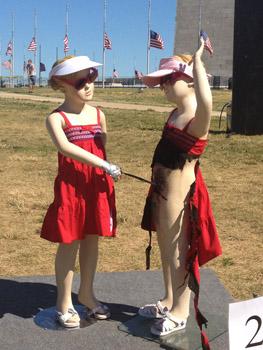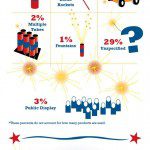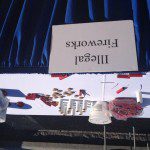Impending Fourth of July celebrations did not stop members of the Consumer Product Safety Commission (CPSC) from detonating fireworks and explosives June 26 on the National Mall. As part of its annual fireworks safety demonstration, the commission reenacted seven dangerous scenarios based on information staffers collected in 2011 of injuries sustained by fireworks. The demonstration also featured guest speakers from introduced the Pipeline and Hazardous Materials Safety Administration (PHMSA) and the Bureau of Alcohol, Tobacco, Firearms, and Explosives (ATF).
From bottle rocket blunders and sparkler slip-ups to homemade firework flops, the CPSC displayed the consequences even the slightest misuse could cause. As onlookers watched and heard the snaps, crackles, and pops of products such as m-1000s, quick match professional fuses, and aerial shells, test mannequins lost limbs and watermelons were obliterated. The finale of the demonstration featured a replication of a homemade firework that killed a 51-year-old man last year. Once detonated, the tiny living room display was instantly blown to pieces within seconds.
CPSC Chairman Inez Tenenbaum said that 9,600 persons were treated in U.S. hospitals last year for fireworks-related injuries and four deaths occurred. Some of these injuries included severe burns and loss of fingers. As for the deaths, which were caused by illegal devices, the victims suffered from head and face trauma when the device exploded. In one instance, a victim was decapitated. Moreover, according to the CPSC, 65 percent of all fireworks injuries in 2011 were sustained during the 30 days surrounding Independence Day. In regards to illegal fireworks, Tenenbaum urged the public to heed the CPSC’s warnings. “Don’t make them, don’t purchase them, and don’t go near them,” she said.
She went on to introduce the PHMSA Administrator, Cynthia Quarterman, who provided guidelines on fireworks transportation safety. Quarterman said PHMSA is responsible for approving the safety of fireworks used for both the annual Independence Day and the Cherry Blossom celebrations held on the National Mall. Quarterman added that although PHMSA, CPSC, and ATF are separate entities, they are bound by one, common goal. “We want to assure that everyone has a fun and safe Fourth of July,” she said. An overlooked aspect of fireworks safety, she mentioned, was the transportation of fireworks. As a result, Quarterman provided five tips to prevent firework transportation fatalities. First, never attempt to light fireworks in a car. Second, never smoke while lighting fireworks. Third, when transporting fireworks, place them in the trunk. Fourth, always transport fireworks in a spark-proof container such as a cardboard box. Finally, when driving a vehicle that does not have a trunk, keep fireworks out of the sunlight.
Following Quarterman, the Assistant Director of Enforcement Programs and Services for ATF, Arthur Herbert, explained how to spot the differences between legal and illegal fireworks and explosives. While legal fireworks are typically brightly colored, illegal fireworks, some commonly known as m-80s, m-1000s or cherry bombs, are either wrapped in plain, brown or silver tubes and are unlabeled. “Know the difference before you buy,” Herbert said. “Both are extremely dangerous even if they aren’t misused.” His personal safety tips were two-fold: leave firework detonations to the professionals and, more importantly, abide by the law. Federal permits are required to detonate and distribute fireworks. With Independence Day quickly approaching, be sure to check out the CPSC’s fireworks statistics to help keep you and your family safe this holiday.





